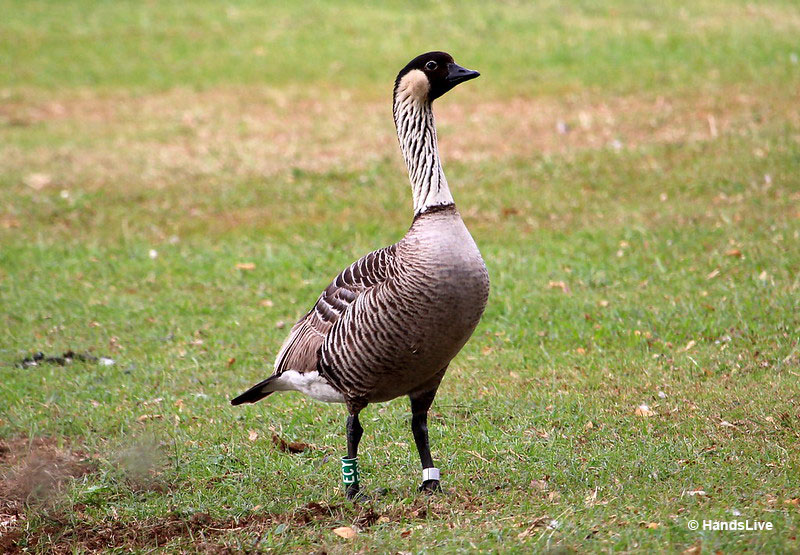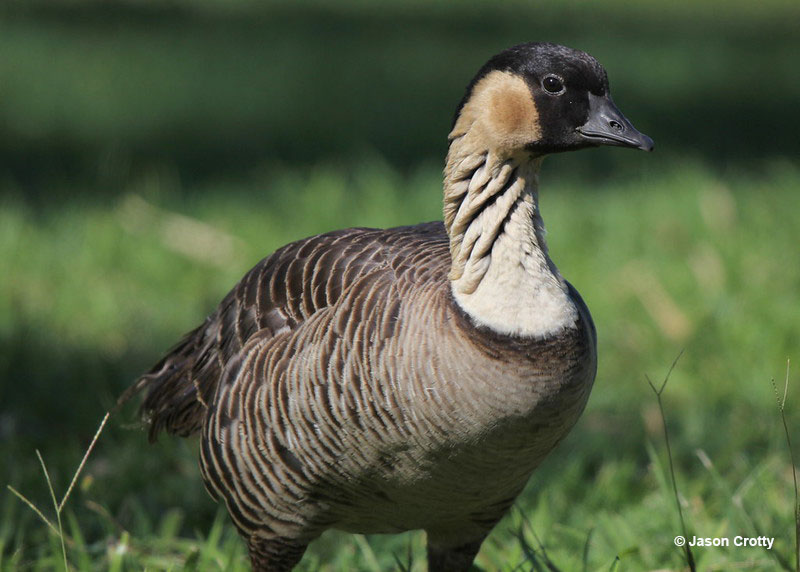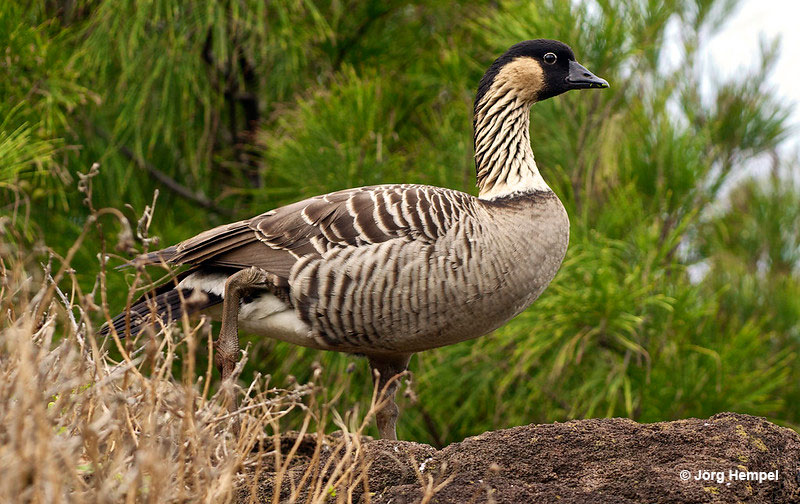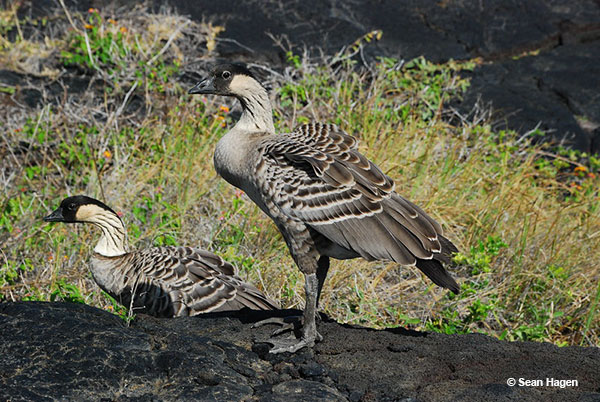
Hawaii state bird is the Hawaiian Goose. Also known as the “Nēnē”, this unique species related to the Canada Goose only occurs in Hawaii, and nearly went extinct in the 1940s.
However, thanks to years of captive breeding and a lot of hard work to keep this species alive, the Hawaiian Goose has gone from having a population of just 30 birds to more than 1300 in present times.
Although they are still threatened by lack of habitat, collisions with cars, and other factors, the official state bird of Hawaii can still be readily seen grazing on grass at golf courses and other open, grassy and shrubland habitats.
Hawaii is the eighth smallest state in the USA, the only one located outside of North America, and the only state that is also a tropical archipelago. The Aloha state is 2,000 miles from California and consists of 137 volcanic islands that stretch 1,500 miles across part of the north-central Pacific Ocean.
On this page
Hawaiian State Bird – The History
The Hawaiian Goose became the official state bird of Hawaii in 1957, two years before the territory was declared a state.
This special waterfowl species was chosen to be the state bird even though Hawaii was a territory because it was widely believed that Hawaii would eventually become a state. The Nēnē was also chosen to highlight the importance of this special bird and many other rare plants and animals unique to the Hawaiian Islands.
The campaign to declare the Nēnē the official state bird was aimed at the public in addition to lawmakers, to help local people realize how important it was to respect, admire, and protect their unique and imperiled natural heritage.
The Hawaiian Goose was the perfect candidate for being the official state bird of Hawaii because it doesn’t occur anywhere else, is one of the more unique species of geese, and, where present, is also easy to see. In addition, in 1957, the Nēnē was one of the rarest and most endangered birds in the world.
To keep it from going extinct, this bird was in urgent need of help, and it was hoped that by selecting it to be the state bird, there would be more financial and public support for captive breeding programs and other efforts required to save the Hawaiian Goose from disappearing forever.
That sad fate had already happened to far too many of Hawaii’s endemic birds. Luckily, the Nēnē was saved just in time. In 1967, additional help came in the form of the Nēnē being added to the Federal List of Endangered Species.
Facts about The Hawaii State Bird
- The Hawaiian Goose isn’t the only goose species to have lived in the Hawaiian archipelago. Based on fossil evidence, several other large, flightless waterfowl species are also believed to have occurred in Hawaii. Sadly, all became extinct, most or all likely after the first people arrived on Hawaii.
- Like other species adapted to unique island environments, the Hawaiian Goose is not as adaptive as other, continental bird species. Birds on islands can quickly become highly evolved to only live in certain conditions, eat certain food, and only avoid certain types of predators. The Nēnē is no exception.
- The Nēnē is a terrestrial goose that can walk, run, and hop much better than other geese species. Its feet and legs are adapted for standing and walking on rough, volcanic terrain.
- In the past, the Nēnē occurred on all or most of the Hawaiian Islands in open woodlands and grassland habitats. In current times, it has become restricted to Maui, Moloka’i, Hawai`i Island, and Kaua’i.
- The Hawaiian Goose was on the brink of extinction when it was chosen to represent Hawaii. Reportedly, there were only 30 birds left by 1952. Even though the Nēnē populations increase, they are still considered to be in a vulnerable state and are considered to be the world’s rarest goose species.
Identification
The Hawaiian Goose is the only native goose species that still occurs on the Hawaiian Islands and is also the largest extant species of native Hawaiian waterfowl. The male Hawaiian Goose is a medium-sized goose with a medium-length, black bill, and rather long, black legs with partially webbed feet.
It has a velvet black head with a large orange-buff-colored patch on the side of the face, and a pale, narrow eyering. The neck is buff or cream colored with wavy black streaks, there is a black line on the back of the neck, and it has a blackish border where it meets the breast.
The back is dark, gray-brown with white barring, and the breast and belly are silvery-buff with some faint black barring, and more pronounced black marks on the flanks. The belly is white and it has broad wings and a dark, medium-length tail.
Both sexes of the Nēnē look nearly the same, although the female has paler plumage and is slightly smaller than the male. The Hawaiian Goose is 23 to 27 inches in length and males weigh anywhere from 3.5 pounds to 6.61 pounds.
Female Hawaiian Geese weigh 2.8 pounds to 5.64 pounds. Immature birds older than five months of age look just like adults.
Interestingly, their breeding season is quite long – from August to April. They lay eggs somewhere in between November and January. The incubation process takes around 30 days, after which the goslings hatch. The goslings stay with their parents until the next breeding season.
Call
This Hawaiian species makes typical, honking, goose-like sounds usually given as double noted calls followed by a few, lower-pitched guttural calls.
They can sound somewhat like the familiar Canada Goose but are quieter and don’t sound nearly as intrusive. Pairs of this goose species make these loud calls to locate each other when they are separated, when they defend their territories from other Hawaiian Geese, and also make similar but quieter calls in flight.
Like other geese, to deter predators as well as other geese, they make a hissing sound. While foraging in small family groups, the Hawaiian Goose also makes brief and quiet honking calls and other sounds to stay in touch and communicate with each other.
What do they eat?
Hawaiian Geese are big fans of plant matter. They eat grass, leaves, flowers, seeds, and fruit.
Behavior
Hawaiian Geese form pairs and often live in small family groups. They are social within their family groups but can be aggressive to other geese invading their territory. Hawaiian Geese like pastures, shrubs, volcanic areas, and can even live near lava flows. They live well in captivity, too.
When defending territory and protecting their young goslings, this species lowers its neck and holds it close to the ground while hissing and rushing at the threat. If they end up fighting with another goose, each bird uses its beak to grab the opponent at the base of the neck and then hit with their wings.
Historic predators of the Hawaiian Goose probably included owls and other raptor species that became extinct in the Hawaiian Islands more than 1,000 years ago.
In present times, their main predators are introduced species, especially the Small Indian Mongoose, a predator that preys on eggs, young birds, and occasionally kills adults. Other predators include rats, pigs, cats, and feral dogs. Although the Nēnē was heavily hunted in the past, thanks to federal protection and education, this is no longer the case.
As a result, they can be quite tame around people and can also hiss and make bluff attacks at folks who venture too close to their nests.
Other Birds You Can See In Hawaii
Since Hawaii is quite far from the mainland, there are some different species. Here are some of the most common ones:
- Common Myna
- Zebra Dove
- Warbling White-eye
- Spotted Dove
- House Finch
- House Sparrow
- Cattle Egret
- Northern Cardinal
See more – most common birds of Hawaii
Good To Know – Hawaii State Symbols
Endemic tree: ʻŌhiʻa lehua, found only in Hawaii. These evergreen trees can grow up to 82 feet high, and depending on species, blooms are red or orange (some species even have yellow or pink flowers).
Fish: Humuhumunukunukuāpuaʻa, also known as Reed Triggerfish. They live on a much larger area – this fish is found at Indo-Pacific reefs.
Flower: Pua aloalo or maʻo hau hele, also known as Hawaiian hibiscus. There are different subspecies, but the correct flower is Hibiscus brackenridgei, a tall shrub with yellow flowers.
Insect: Pulelehua, or the Kamehameha Butterfly – a beautiful red butterfly with close ties to the endemic tree.
Land mammal: ʻŌpeʻapeʻa, also known as Hawaiian Hoary Bat. They are found on larger Hawaiian islands, but are still considered to be endangered.
Mammal: ʻĪlioholoikauaua, simply known as the Hawaiian Monk Seal. They are native to the islands.
Marine mammal: Koholā, also known as the Humpback Whale. This is the only species that is widespread and found in every ocean.
Plant: Kalo, also known as Taro – a vegetable used in different cultures (more notably in Asian and African cultures).
Tree: Kukui tree, also known as Candlenut tree. It’s a tropical plant growing in rainforests and gallery forests.
Frequently Asked Questions
What is the state bird of Hawaii?
The state bird of Hawaii is the Hawaiian Goose, also known as the Nēnē.
Why is the Hawaiian Goose the state bird of Hawaii?
The Hawaiian Goose is the state bird of Hawaii because it is an endemic bird species found exclusively in the Hawaiian Islands. It is considered a symbol of Hawaii’s unique and fragile ecosystem. The Hawaiian Goose has faced significant population declines and conservation efforts have been made to protect and preserve this native bird species.
When did Hawaii choose its state bird?
Hawaii designated the Hawaiian Goose as its state bird in 1957.
What other states have the Hawaiian Goose as their state bird?
The Hawaiian Goose, or Nene, is not recognized as the state bird of any other states. It is specific to Hawaii and holds significance as an emblem of the islands’ natural heritage.




